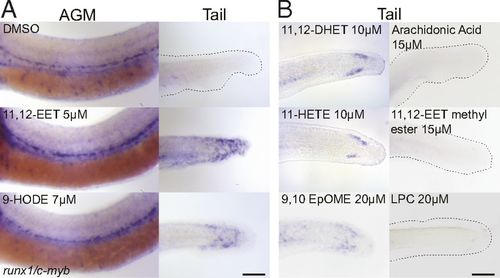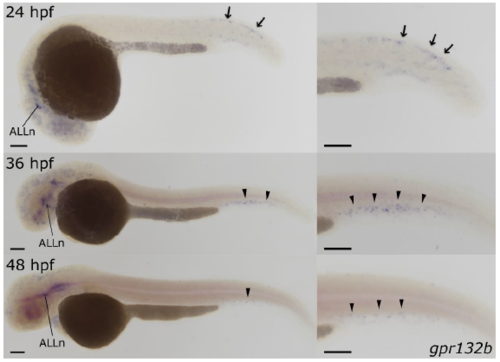- Title
-
Specific oxylipins enhance vertebrate hematopoiesis via the receptor GPR132
- Authors
- Lahvic, J.L., Ammerman, M., Li, P., Blair, M.C., Stillman, E.R., Fast, E.M., Robertson, A.L., Christodoulou, C., Perlin, J.R., Yang, S., Chiang, N., Norris, P.C., Daily, M.L., Redfield, S.E., Chan, I.T., Chatrizeh, M., Chase, M.E., Weis, O., Zhou, Y., Serhan, C.N., Zon, L.I.
- Source
- Full text @ Proc. Natl. Acad. Sci. USA
|
gpr132b is required for EET’s enhancement of zebrafish developmental hematopoiesis. (A) Single-cell zebrafish embryos were injected with 4–6 ng gpr132b MO or control MO or were uninjected, and then treated with DMSO or 5 μM 11,12-EET beginning at 24 hpf. Embryos were fixed at 36 hpf and stained for runx1 expression. (Scale bar, 100 μm.) (B) Embryos were scored as having high or normal runx1 expression in the AGM, and high (present) or normal (absent) runx1 expression in the tail mesoderm. Graph presents summary of several experiments, total number of embryos at base of each column. Two-tailed Fisher’s exact test. Ctrl includes control MO injected and uninjected embryos. |
|
Fatty acid GPR132 activators enhance expression of HSPC markers in zebrafish embryos. (A) ISH of zebrafish embryos treated with DMSO, 11,12-EET, or 9-HODE showing AGM and tail expression of runx1/c-myb. For full quantification, see SI Appendix, Table S1. (B) ISH of zebrafish embryos treated with diverse free fatty acids, EET-methyl ester, and LPC showing tail expression of runx1/c-myb. For full quantification, see SI Appendix, Table S1. (Scale bar, 100 μm.) |
|
gpr132b expression in zebrafish embryos. ALLn, anterior lateral line nerve. Arrows indicate dorsal nervous system staining at 24 hpf. Arrowheads indicate punctate staining in the CHT region at 36 and 48hpf. Scale bars are 100μM. |



